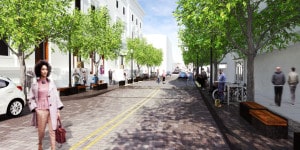
The proposed condition for Gainsborough Street features new custom granite street furniture and a digital music ground plane motif that emphasizes the street as a new space for NEC, students, pedestrians and cyclists.
New England Conservatory (NEC) will celebrate its 150th anniversary in September with the opening of its Student Life and Performance Center (SLPC), a new hub for performance, practice and residential life open to the public as part of NEC’s commitment to sharing music with the Boston community.
While the new state-of-the-art, multipurpose facility extends NEC’s long tradition of public engagement through new performance facilities, the project’s streetscape component equally extends the building – and the campus – into the public realm for the benefit of students, faculty and the city of Boston.
Ann Beha Architects, design architect, with Gensler as executive architect, designed the new SLPC, which is the fourth building on the NEC campus that stretches along St. Botolph Street and Huntington Avenue, with the Gainsborough Street intersection at the center. CRJA-IBI Group designed vibrant streetscapes on St. Botolph and Gainsborough streets, creating a distinct sense of campus for these four buildings and providing an active outdoor amenity for NEC and the neighborhood.
The new pedestrian-focused streetscapes defining NEC’s campus were designed using Boston’s Complete Streets guidelines, a city initiative that aims to improve the quality of life in Boston by creating streets that are both great public spaces and sustainable transportation networks. The Complete Streets approach places pedestrians, bicyclists and transit users on equal footing with motor-vehicle drivers, and embraces innovation to address climate change and active healthy communities.
Boston’s Complete Streets guidelines establish new standards for street design and reconstruction projects, and as one of the first projects in the city using this approach, CRJA’s designers tried to implement the guidelines to further the goals of the SLPC project as much as possible. The public portion of the St. Botolph/Gainsborough streetscape is a city of Boston project, administered and funded by Mass DOT using federal grants, with design review by New England Conservatory.
Streetscape Inspired By Music
To create a multi-modal streetscape that is safe and shared comfortably by all users, the design holistically applied the Complete Streets guidelines to change the traffic balance from cars to pedestrians by adopting a design ratio that removed street parking, narrowed travel lanes, provided amenity for cyclists on sections of St. Botolph and Gainsborough streets, and allocated more space for pedestrians, outdoor seating and sidewalk performers (beyond the city’s five-foot concrete sidewalk requirement).
A functional streetscape was designed on both sides of the property line, melding the exterior building features of the SPLC seamlessly with the city sidewalk. For example, stepped seating leading up to the SPLC entrance creates an amphitheater space for outdoor performance and beckons pedestrians to pause for musical enjoyment. The project features custom site furniture, new paved pedestrian- and bicycle-focused streets and sidewalks, and enhanced intersections and crosswalks.
The streetscape designs are inspired by themes of analog and digital music to create a unique and identifiable character for the NEC campus. In front of the new SPLC building on St. Botolph Street, analog music is the story: narrow and elongated granite pavers are laid out to represent a musical staff, with granite seats sculpted to look like musical notes. Rectangular wood and granite benches are precisely placed on this musical staff, providing a “musical rest” – both literally and figuratively.
NEC’s forward-thinking, digital music focus is conveyed in the pixilated and structured design on Gainsborough Street. Custom granite pavers are positioned on the expanded sidewalk in a grid pattern that is inspired by patterns created by digital music notation – a graphic equalizer effect. The design is carried over the granite curb and into the street, where concrete unit street pavers emphasize the pedestrian realm. Yellow brick pavers in lieu of painted roadway lines stay on theme. Custom wood and granite furniture provide seating on both sides of the street. In front of NEC’s Jordan Hall, the street is raised to sidewalk level, both as a traffic calming measure as well as a seamless pedestrian zone to the resident hall across the street. The feature is perceived as a mini-plaza connecting the NEC campus.
Finally, Boston sculptor David Phillips was commissioned to create interior and exterior artwork for the SLPC, including a 17-foot-high, stainless steel structure abstracted from a violin’s scroll. CRJA located the sculpture in a new “pocket” park on the corner of St. Botolph and Gainsborough streets.
When fully complete, the St. Botolph and Gainsborough streetscapes will provide enhanced campus identity for NEC, new exterior space for students and a dynamic public realm for this truly urban campus.
Christopher C. Bridle is a senior associate and a design leader at CRJA-IBI Group, an award-winning landscape architectural design and environmental planning practice with offices in Boston and Knoxville.








